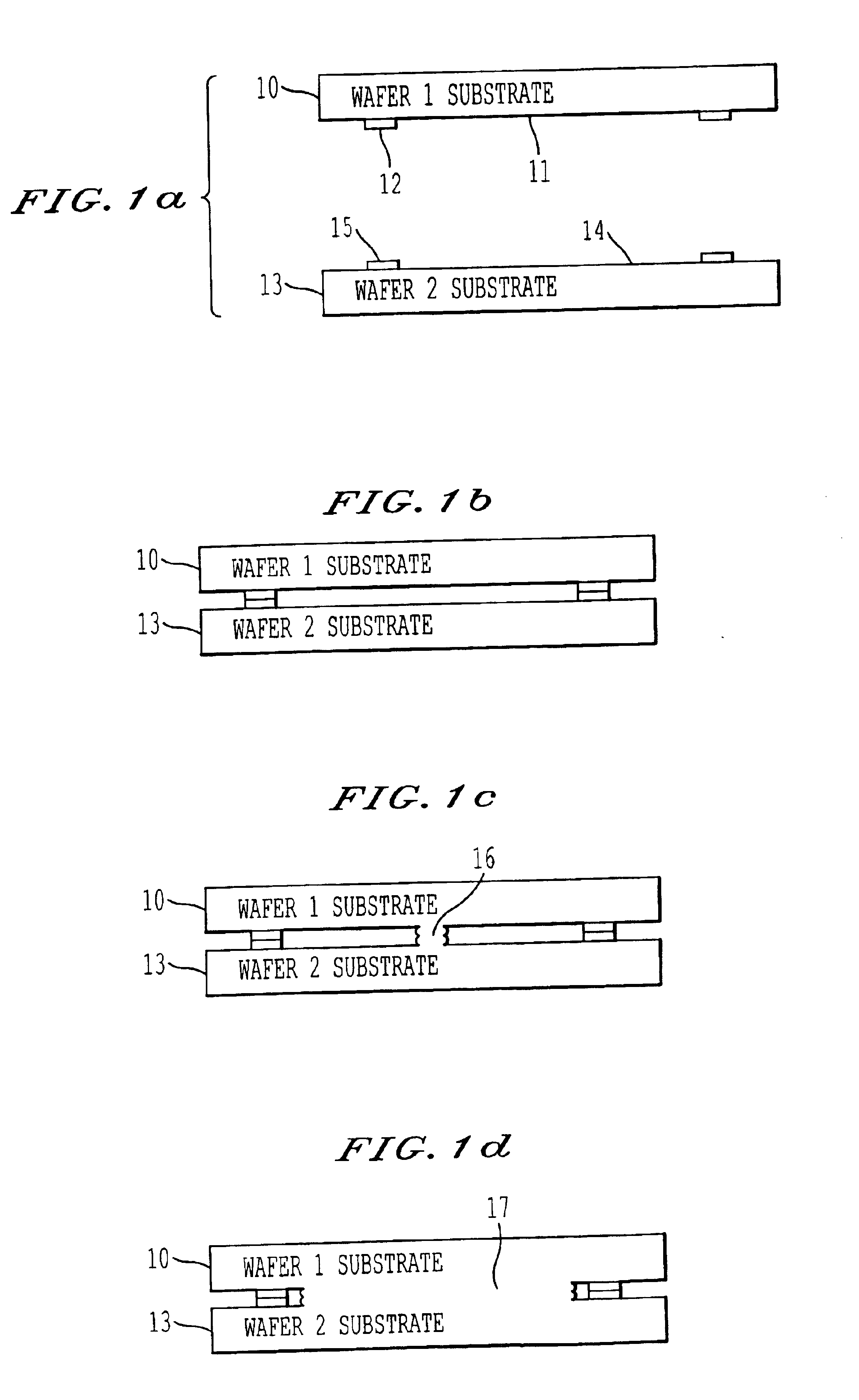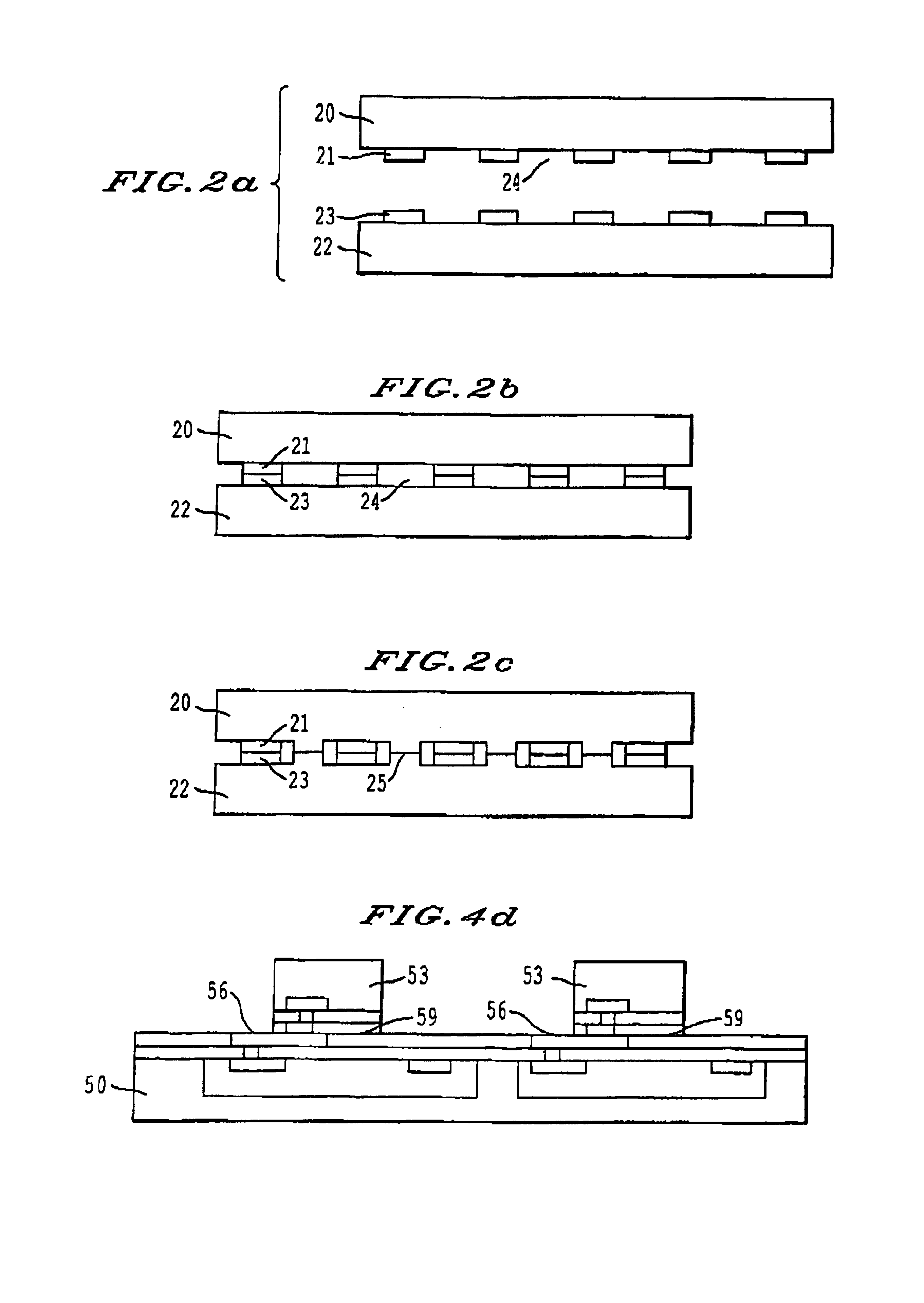Method for room temperature metal direct bonding
a direct bonding and metal technology, applied in the direction of non-electric welding apparatus, manufacturing tools, solid-state devices, etc., can solve the problems of high defect density of hetero-epitaxial grown films, dislocation generation, debonding or cracking, and difficult optimization of process design needed to produce different functions on the same chip containing different materials
- Summary
- Abstract
- Description
- Claims
- Application Information
AI Technical Summary
Benefits of technology
Problems solved by technology
Method used
Image
Examples
first embodiment
[0057]In one example of the present invention, 5 mm diameter Au bonding pads with a thickness less than 300 Å and a separation distance of 1 mm were deposited on oxide covered 100 mm silicon wafers. Since the Au bonding pads were formed on the surface of the oxide, they also had a height of 300 Angstroms above the surface of the oxide. However, h can be much smaller than actual metal thickness since metal cam be partially buried in oxide or other insulator and h is the height the metal extended above the die surface. A room temperature bonding technology has been developed that cleans and activates the metal and the oxide surfaces compatibly and simultaneously. The Au posts formed a metallic bond by room temperature bonding at wafer level in ambient without using external pressure after storage in air for a period of time, e.g. 60 hr depending on the metal thickness and bonding energy. When the wafer pairs were forcibly separated, by inserting a wedge between the bonded interface, e...
second embodiment
[0059]FIGS. 3A-3C are schematic drawings of a process according to the present invention, by which two different fully processed dies are bonded. The dies are shown to have planar but uneven layer thickness, to demonstrate that the invention may be used in other instances other than even and planar layer thicknesses. In this process, as shown in FIG. 3A, a separate die 30 (only the oxide layer of die 30 is shown, for convenience of explanation) has metal pads 31. The die may be a silicon wafer including semiconductor devices and circuits have opposing surfaces of SiO2. Surface 32 results after a CMP operation.
[0060]As shown in FIG. 3B, vias 36 have been formed and filled with metal to connect with metal pads 31, metal interconnects 33 are formed on wafer 30 to connect with the metal in vias 36, and a layer 34 of thickness t2, of SiO2 or other insulating material is formed on wafer 30. Portions 35 of the SiO2 layer having a width w2 have been removed to expose metal pads 35. The surf...
third embodiment
[0081]the invention allows a significant increase in the metal height above the non-metal surface and / or significant reduction in non-bonded area near the metal while maintaining an acceptable electrical connection between metal portions formed on separate wafers. In this embodiment, deformation of material in the vicinity of the metal material that forms the electrical contact is designed to result from the pressure at the metal surfaces from the wafer-to-wafer chemical bonding of the non-metal portions. This deformation may result in less pressure applied to the metal after the bonding process is complete, but adequate pressure to form an acceptable electrical connection between the metal portions. This deformation allows the gap near the metal surfaces to be significantly reduced or eliminated.
[0082]The object of the deformable material in the vicinity of the metal material forming the electrical contact is to allow the pressure generated by the chemical bonding of the non-metal ...
PUM
| Property | Measurement | Unit |
|---|---|---|
| compressive pressure | aaaaa | aaaaa |
| compressive pressure | aaaaa | aaaaa |
| pressure | aaaaa | aaaaa |
Abstract
Description
Claims
Application Information
 Login to View More
Login to View More - R&D
- Intellectual Property
- Life Sciences
- Materials
- Tech Scout
- Unparalleled Data Quality
- Higher Quality Content
- 60% Fewer Hallucinations
Browse by: Latest US Patents, China's latest patents, Technical Efficacy Thesaurus, Application Domain, Technology Topic, Popular Technical Reports.
© 2025 PatSnap. All rights reserved.Legal|Privacy policy|Modern Slavery Act Transparency Statement|Sitemap|About US| Contact US: help@patsnap.com



